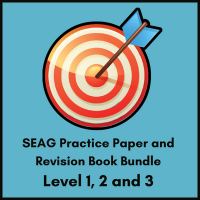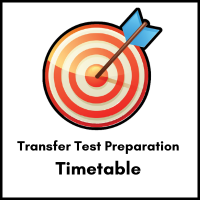
How to Help Your Child Avoid Silly Mistakes in the SEAG Transfer Tests
One of the most common questions we’re asked by parents at this time of year is:
“How can I help my child stop making silly mistakes in the SEAG Transfer Tests?”
It’s a very real concern — and an incredibly common one. Silly mistakes in the SEAG Transfer Tests can cost children marks they absolutely could have earned. These are not knowledge gaps or major misunderstandings — they’re simple, avoidable errors that often come down to rushing, misreading, or inconsistent exam habits.
The good news? With the right strategies and some small but consistent adjustments, these mistakes can be significantly reduced — and sometimes eliminated entirely.
In this article, we’ll break down why silly mistakes happen and how you, as a parent, can help your child avoid them as they prepare for the SEAG Transfer Tests.
What Causes Silly Mistakes in the SEAG Transfer Tests?
Silly mistakes in the SEAG Transfer Tests are usually the result of:
- Misreading or skimming through the question
- Rushing through easier questions or running out of time
- Overconfidence when a topic looks familiar
- Not checking answers at the end
- Gaps in revision or unclear understanding of a topic
Understanding where these errors come from is the first step in helping your child make improvements — and gain confidence going into the test.
Proven Tips to Reduce Silly Mistakes in the SEAG Transfer Tests
Martin, our Transfer Test expert with over 18 years of success in preparing children for the Transfer Tests, shares his top tips to help students avoid losing marks unnecessarily.
1. Treat Every Question with Equal Focus :
Children often rush through questions they think are “easy,” which leads to simple errors. Help your child develop the habit of treating every question — whether it looks easy or hard — with the same level of care and attention.
2. Always Read the Full Question:
A major cause of silly mistakes in the SEAG Transfer Tests is assuming what a question is asking without reading it properly. Children may recognise part of the question and think, “Oh, I’ve seen this before,” but that assumption can lead them in the wrong direction. Encourage your child to always read all of the instructions before answering.
3. Targeted Revision is Key:
Silly mistakes often come from weak areas that weren’t fully understood. Keep a revision notebook where your child can write down topics they need to review after each practice test. Ensure they’ve revised all relevant topics before sitting another practice paper, so the results give a true reflection of where they are.
4. Use a Methodical Approach: Having a clear, consistent method for tackling questions is vital. Teach your child to:
- Break the question into steps.
- Highlight or underline keywords or numbers
- Work through the problem logically
- This process helps reduce the likelihood of silly mistakes and builds exam confidence.
5. Check Your Work — Every Time
Developing a habit of double-checking answers is one of the simplest ways to reduce silly mistakes in the SEAG Transfer Tests. Whether it’s checking calculations, units, or the placement of the answer in the correct box — this small habit can lead to big improvements.
Making the Most of the SEAG Test Format
The SEAG Transfer Tests include both multiple-choice and free-response sections. Each format comes with its own advantages and challenges:
- Multiple-Choice Questions: These act as a safety net. If a student makes a mistake in their working, their answer may not appear among the options — giving them the opportunity to spot the error and try again. This feature is especially helpful for students who may be dyslexic or prone to calculation slips.
- Written Answers: These must be written clearly in the correct space. It’s easy to lose marks simply by placing the answer in the wrong box. Encourage your child to stay organised and accurate when completing written responses.
Extra Strategies to Avoid Silly Mistakes in the SEAG Transfer Tests
- Underline key words in wordy questions
- Estimate answers to check if they’re reasonable
- Watch for commonly confused terms (e.g., perimeter vs. area)
- Stay calm — avoid rushing, especially under pressure
A Motivating Tip for Parents
When marking your child’s practice paper, try this technique:
Record both their actual score and the score they would have achieved without silly mistakes.
This helps your child see how small errors impact their final result — and it gives them a clear, achievable goal: reduce the number of silly mistakes in each test going forward. Over time, you’ll likely see a real shift in their focus, motivation, and results.
Final Thoughts
Silly mistakes in the SEAG Transfer Tests are frustrating — but they’re also fixable. With your encouragement and a few smart strategies, your child can approach the exam with more clarity, confidence, and control. Reducing avoidable errors is one of the easiest ways to boost a score, and it often comes down to focus, method, and revision.
If you’d like expert guidance or tailored support as your child prepares for the Transfer Test, we’d be delighted to help. Visit our tuition website to learn more about our SEAG Transfer Test tuition services.
Browse of range of SEAG Style Practice Papers
SEAG Level 1 and 2 Practice Papers
-
Transfer Test SEAG Style Practice Papers – Level 2
Price range: £8.00 through £21.00
Price range: £6.40 through £16.80
SEAG Style Level 3 Practice Papers (Test Level)
-
Transfer Test SEAG Style Practice Papers – Level 3
Price range: £8.00 through £72.00
Price range: £6.40 through £57.60 -
SEAG Bonus Practice Paper
£5.00£4.00
Transfer Test Revision Books
-
Transfer Test Revision and Practice Paper Bundle
Price range: £45.00 through £102.00
Price range: £36.00 through £81.60 -
Transfer Test Maths and English Revision Books
£45.00
£36.00







Hello ontargetresources.co.uk admin, Great post!